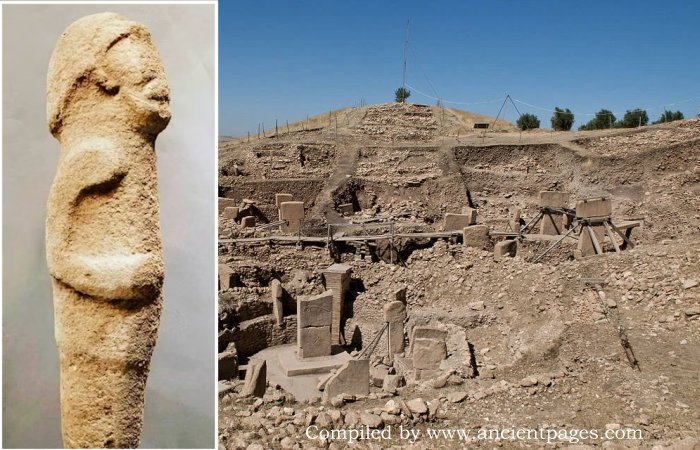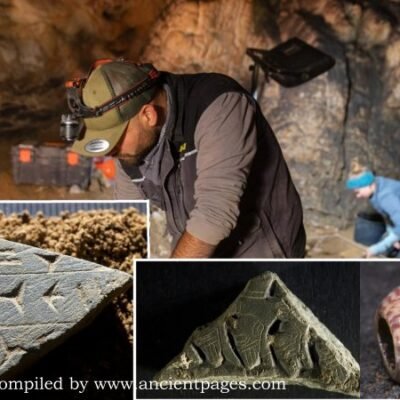Jan Bartek – AncientPages.com – Archaeologists have made a significant discovery at the Neolithic site of Göbekli Tepe in Türkiye, unearthing a rare human statue. This 11,500-year-old site is renowned as the world’s oldest temple and offers crucial insights into early human civilization.
Göbekli Tepe. Credit: Teomancimit – CC BY-SA 3.0
The discovery of the temples at Göbekli Tepe by German archaeologist Klaus Schmidt has provided significant insights into early human civilization. Schmidt, who had previously worked on the Nevali Çori site, found that Göbekli Tepe predates it. The hunter-gatherers responsible for building these temples lived in an era before writing, metalworking, or pottery existed. This was a time when it was believed that humans had not yet formed organized religious practices involving priests and sacrifices. Despite this, these Neolithic people managed to organize themselves to cut and transport massive 16-ton stone pillars up a hill and arrange them in a circular pattern for ritualistic purposes.
The site is notable for its abundance of Neolithic flint tools such as knives, choppers, and projectile points. While these tools are typical of the period, their sheer quantity at this religious site is extraordinary. This challenges previous assumptions held by historians and archaeologists about the existence of temples and religious practices during this time.
The human sculpture was discovered embedded within this wall. Credit: Türkiye Ministry of Culture
Klaus Schmidt theorized that Göbekli Tepe served as a pilgrimage destination attracting worshippers from as far as 160 kilometers (100 miles) away. The findings suggest that humanity’s sense of the sacred—and love for grand spectacles—may have been pivotal in giving rise to civilization itself. As Schmidt famously stated, “First came the temple, then the city,” proposing that civilization emerged not primarily due to ecological factors but rather from human cognitive development—a theory poised to reshape archaeological perspectives and our understanding of history.
Türkiye’s Culture and Tourism Minister, Mehmet Nuri Ersoy, revealed that the statue was recently found embedded in a wall at Göbekli Tepe (“Hill with a Navel”, or “Potbelly Hill”) and is believed to have been left as a votive offering. This finding could provide new understanding of religious practices from that era.
The announcement coincided with a ceremony highlighting recent restoration efforts at this UNESCO World Heritage Site. The statue features an intact head and torso but lacks feet, positioned horizontally within a wall between two key enclosures known as Structure B and Structure D. Human representations are uncommon at Göbekli Tepe, making this discovery particularly noteworthy.
Göbekli Tepe predates Stonehenge by approximately 6,000 years and is famous for its T-shaped limestone pillars adorned with animal carvings like foxes, snakes, and wild boars. These pillars are arranged in circular formations believed to have hosted communal rituals.
Minister Ersoy emphasized that this “highly valuable” human figure enriches our understanding of the site’s historical context. While Göbekli Tepe has traditionally been viewed as focusing on animals and symbolic motifs in its ritualistic functions, the newly discovered statue indicates that human imagery also played a significant role in Neolithic spiritual life.
The human sculpture was discovered embedded within this wall. Credit: Türkiye Ministry of Culture
In addition to announcing the discovery, Ersoy discussed ongoing restoration work at Göbekli Tepe. Efforts include reinforcing Structure C—the largest enclosure—with walls rebuilt and pillars restored to their original documented positions. Minister Ersoy highlighted Göbekli Tepe not just as an archaeological site but as humanity’s collective memory, underscoring our shared duty to preserve this heritage for future generations.
In his address, Minister Ersoy outlined several upcoming initiatives aimed at enhancing visitor infrastructure. These plans include the establishment of a new management center, the creation of a parking area, and the development of a network of pedestrian walkways, all expected to be operational by the end of 2025.
See also: More Archaeology News
Additionally, he mentioned the relocation of around one thousand olive trees to support ongoing research efforts. Furthermore, he announced the introduction of new geomagnetic surveys designed to accurately map the subsoil. This will aid in developing an efficient excavation strategy for future archaeological campaigns.
Written by Jan Bartek – AncientPages.com Staff Writer








